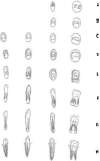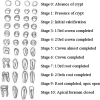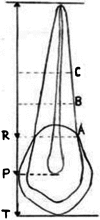Dental radiographic indicators, a key to age estimation
- PMID: 21493876
- PMCID: PMC3520308
- DOI: 10.1259/dmfr/19478385
Dental radiographic indicators, a key to age estimation
Abstract
Objective: The present review article is aimed at describing the radiological methods utilized for human age identification.
Methods: The application and importance of radiological methods in human age assessment was discussed through the literature survey.
Results: Following a literature search, 46 articles were included in the study and the relevant information is depicted in the article. Dental tissue is often preserved indefinitely after death. Implementation of radiography is based on the assessment of the extent of calcification of teeth and in turn the degree of formation of crown and root structures, along with the sequence and the stages of eruption. Several radiological techniques can be used to assist in both individual and general identification, including determination of gender, ethnic group and age. The radiographic method is a simpler and cheaper method of age identification compared with histological and biochemical methods. Radiographic and tomographic images have become an essential aid for human identification in forensic dentistry, particularly with the refinement of techniques and the incorporation of information technology resources.
Conclusion: Based on an appropriate knowledge of the available methods, forensic dentists can choose the most appropriate since the validity of age estimation crucially depends on the method used and its proper application. The multifactorial approach will lead to optimum age assessment. The legal requirements also have to be considered.
Figures



 crown completion for anterior teeth, the fused cusps of deciduous first molar, five cusps of the deciduous second molar and the crypt of permanent first molar with no evidence of mineralization
crown completion for anterior teeth, the fused cusps of deciduous first molar, five cusps of the deciduous second molar and the crypt of permanent first molar with no evidence of mineralization











Similar articles
-
[The role of the dentist in modern forensic age determination].Schweiz Monatsschr Zahnmed. 2008;118(11):1073-88. Schweiz Monatsschr Zahnmed. 2008. PMID: 19066157 French, German.
-
Usability of dental pulp visibility and tooth coronal index in digital panoramic radiography in age estimation in the forensic medicine.Int J Legal Med. 2020 Jan;134(1):381-392. doi: 10.1007/s00414-019-02188-w. Epub 2019 Nov 13. Int J Legal Med. 2020. PMID: 31720771
-
Classifying stages of third molar development: crown length as a predictor for the mature root length.Int J Legal Med. 2015 Jan;129(1):165-9. doi: 10.1007/s00414-014-1011-3. Epub 2014 May 7. Int J Legal Med. 2015. PMID: 24801360
-
Age estimation in the living: A scoping review of population data for skeletal and dental methods.Forensic Sci Int. 2021 Mar;320:110689. doi: 10.1016/j.forsciint.2021.110689. Epub 2021 Jan 14. Forensic Sci Int. 2021. PMID: 33561788
-
Dental age estimation utilizing third molar development: A review of principles, methods, and population studies used in the United States.Forensic Sci Int. 2010 Sep 10;201(1-3):79-83. doi: 10.1016/j.forsciint.2010.04.042. Epub 2010 May 20. Forensic Sci Int. 2010. PMID: 20493649 Review.
Cited by
-
Evaluation of skeletal and dental age using third molar calcification, condylar height and length of the mandibular body.J Forensic Dent Sci. 2015 May-Aug;7(2):121-5. doi: 10.4103/0975-1475.155077. J Forensic Dent Sci. 2015. PMID: 26005300 Free PMC article.
-
Deep Learning Neural Modelling as a Precise Method in the Assessment of the Chronological Age of Children and Adolescents Using Tooth and Bone Parameters.Sensors (Basel). 2022 Jan 14;22(2):637. doi: 10.3390/s22020637. Sensors (Basel). 2022. PMID: 35062599 Free PMC article.
-
Age estimation using pulp/enamel volume ratio of impacted mandibular third molars measured on CBCT images in a northern Chinese population.Int J Legal Med. 2019 Nov;133(6):1925-1933. doi: 10.1007/s00414-019-02112-2. Epub 2019 Jul 4. Int J Legal Med. 2019. PMID: 31273446
-
The coronal pulp cavity index: A forensic tool for age determination in adults.Dent Res J (Isfahan). 2019 May-Jun;16(3):160-165. Dent Res J (Isfahan). 2019. PMID: 31040871 Free PMC article.
-
Age Group Classification of Dental Radiography without Precise Age Information Using Convolutional Neural Networks.Healthcare (Basel). 2023 Apr 8;11(8):1068. doi: 10.3390/healthcare11081068. Healthcare (Basel). 2023. PMID: 37107902 Free PMC article.
References
-
- Saunders E. ‘The Teeth A Test of Age’ considered with the reference to the factory children, addressed to the members of both Houses of Parliament. London: Renshaw, 1837
-
- Eckert WG, Garland N. The history of the forensic applications in radiology. Am J Forensic Med Pathol 1984;5:53–56 - PubMed
-
- Matsikidis G, Schultz P. Alterbestimmung nach dem Gebbis mit Hilfe des Zahnfilms. Zahnarztl Mitt 1982;72:2524–2528 - PubMed
-
- Ciapparelli L. The chronology of dental development and age assessment. In: Clark DH. Practical forensic odontology. Oxford: Wright Butterworth-Heinemann Ltd, 1992, pp 22–42
-
- Masthan KMK. Age and sex. Textbook of forensic odontology. New Delhi: Jaypee Brothers Medical Publishers (P) Ltd, 2009, pp 59–65

